The Bratwurst Revolution
Posted by Guest on Tuesday, November 23rd, 2010Tags for this Article: Ethnic, German, guest, traditional
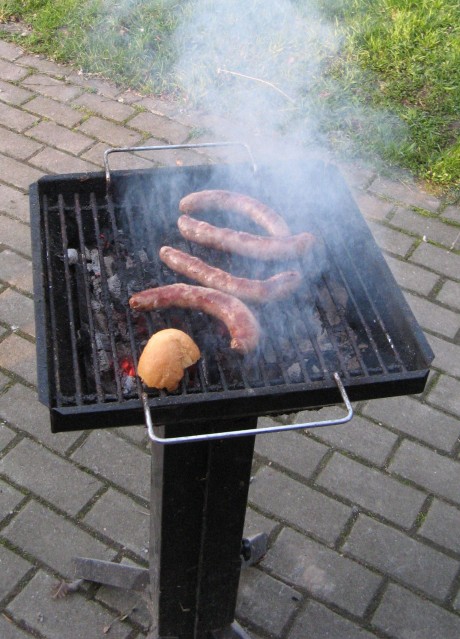
Today’s guest post is by Annika Reinhardt. She was born and raised on a farm with pigs, rabbits, and happy chickens in Eastern Germany. As a child she was the pickiest eater and her parents still can’t believe that she is a huge foodie now. Cooking did not become a priority for Annika until she gained 20lb living in Oklahoma as a high school exchange student. Because, really, there are only so many burgers you can eat! Her mom sent her some German cookbooks and that’s when Annika’s food adventure started and it never stopped. She still feels a bit skittish around fish which she just recently started to eat after catching a barracuda out of a kayak in Belize and overcoming her fear of fish.
Annika is also the proud owner of Social Bites, an exciting dining event in Vancouver. Social Bites offers culinary excursions that provide hobby chefs with an avenue to show off their cooking skills in their own homes and foodies with an opportunity to taste and judge some fabulous dishes.
Annika’s Bratwurst Revolution…
I love German food. Not only because I am German, but because the food is diverse and rich, challenging yet simple. It’s also full of stories. Yes, you heard that right, German food – much like me – talks! German cuisine is very regional and connects with an area’s history and, ultimately, its stories. For example, I have a cookbook which only features dishes from Dresden, and it’s amazing what you can learn about the city just from looking at its food.
Meat
This year, I went to Oktoberfest in Leavenworth, WA and was disappointed with the horrendous food they were selling as “traditional” German cuisine. I was just outraged with the quality and the selection of food that was offered. If I see one more peddler of sausages topped with sauerkraut I might have to scream, since nobody – as far as I recall – eats bratwurst that way in Germany. Nobody!
I am therefore dedicating this article to German food education. Not that all of you need it, but you might be surprised and maybe even learn a thing or two.
I grew up in a small village called Reinsdorf, in Eastern Germany, and was raised in a butcher family. My best friend for some of those years was a pig named Fred. He was my best friend, if only because he would eat the sandwiches I didn’t want in school. We had a great relationship – I fed him, he kept me out of trouble for not eating. It ended – as many great relationships do – on the chopping block. Fred became bratwurst, liverwurst, and pork chops.
Pork was definitively the preferred meat at my house and most dishes my mom made were Eastern European inspired: goulash, rouladen, and lots of dishes with breadcrumbs as filling; tasty and economical. Due to the communist environment, we had to make due with a lot less. We ate well, but very simply as many ingredients just weren’t available to us. I was 10 when I first ate a banana! One dish my mom always made was hard boiled eggs in a mustard sauce with fresh potatoes. It might not seem particularly appealing, but it’s one of those dishes I crave when I go home, and to this day I have never been able to prepare that sauce as creamy and smooth as my mom does.
In the beginning of my cooking adventures, I stuck to family recipes and did not venture out much. Only over the last couple of years have I tried to develop a broader sense of German cuisine and its regional differences.
Spätzle
I have really good friends in Stuttgart, which is in the southwest of Germany. The area is known for many dishes but my favourite is Spätzle, a type of pasta. My mom would never make it because it wasn’t typical of our region but even so, spätzle varies from region to region wherever it’s made. Spätzle from Baden-Württemberg are not the same as Spätzle from an area closer to Austria or Italy. The dough might be similar but the cooking technique is different. In the southwest you use a Spätzle press to push the pasta into cooking water which makes for a longer noodle, whereas in areas further southeast, you shave the dough. The pasta then looks more like rain drops.
Dumplings
Dumplings are another very traditional dish, prepared differently depending on which region you are in. They are served with pork roast, duck, or venison and lots of sauce. They’re tricky to make as the technique is all about timing and working fast. Most dumplings are potato based and if you’re not quick enough preparing them, they’ll turn gray. The most well-known dumplings are probably Thüringer Klösse, from the state of Thuringia, which are made of 2/3 cooked and 1/3 uncooked potatoes. Potatoes are definitively the favourite starch for Germans. Interestingly, they were first cultivated in the north-eastern part of Bavaria in 1647, and today the average German will eat about 150 lbs of potatoes each year!
Herring
But enough with the carbs, let’s talk protein. My paternal grandpa was a butcher; my
maternal grandpa, a fisherman. Apparently my meat-eating genes prevailed for most of my life as I only recently started cooking and eating sea creatures. One of the most popular fish dishes in Germany is called Matjes. Beginning in mid-May and running until the end of June, herring that have not spawned are caught, filleted and prepared with salt, vinegar, sugar, and spices. The soused herring is often served out of street food carts in a fresh bun with raw onions. According to some of my German friends it is the best hangover food.
I feel that even though I’ve grown up in Germany, there are still so many dishes to discover and stories to uncover. I will continue to explore fine German food and, if you’re interested, come and join me on my quest.

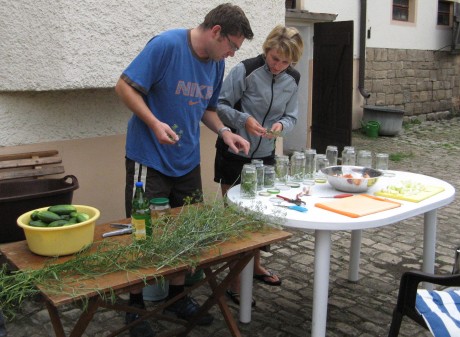
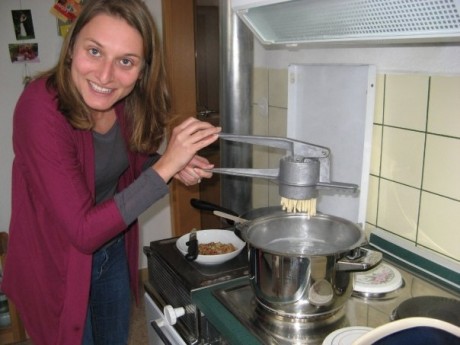
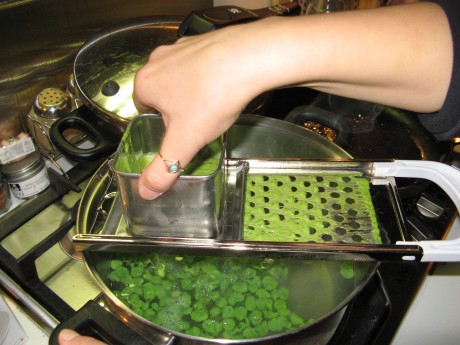
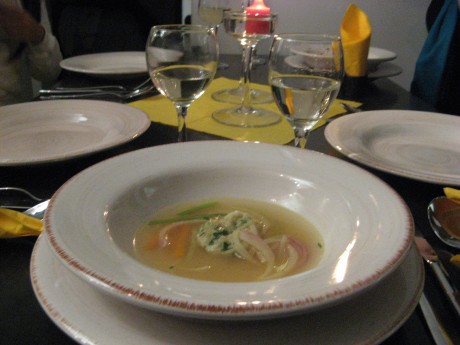


Posted on November 23rd, 2010
Kaishin says:
Great post Annika. Glad you’ve ventured into sea creatures ;)Till our next foodie gluttony outing, and yes please for German food exploration!
Kai
Posted on November 24th, 2010
Annika says:
Kai, thank you! German Christmas Market might be our first German food/drink outing…@bmann ‘s smart idea.
Also, I had a couple people ask me where to by a Spaetzle press. I actually don’t own one, the picture is taken in Stuttgart but if you know of a place in Van where you can buy them, let us know. I do own the “shaver” which a friend from Austria sent me as it is more traditional there. Plus it is a lot lighter, the press is a serious piece of equipment.
Any other questions, please ask!
Posted on November 24th, 2010
Ben Garfinkel says:
Pretty sure you can substitute a potato ricer for a spaetzle press. The one I have even comes with two ‘plates’with different size holes. Available a decent kitchen shops everywhere.
Posted on November 25th, 2010
Haike says:
Ive tried a potato ricer, but its just not the same. I would love a real spaètzle press if I can get one. If anyone knows where to find one in Vancouver, I would be grateful.
Posted on November 25th, 2010
Joseph Wu says:
I’ve always been partial to spaetzle that was cut off the edge of the board. More noodle-like and a little more chewy.
Posted on November 26th, 2010
Mark Busse says:
I have a traditional spaetzle board if anyone wants to give it a go. My favourite is to pan fry them after boiling them to give them a chewy texture. So good.
Posted on November 26th, 2010
Annika says:
Mark, yours must be similar to mine then. You shave the dough into the water, like in the second pic? Not as estatic as the real noodles but I like them. I pan fry mine too, add cheese and serve with reduced beef stock + fried onions.
Also very good – spinach Spätzle with ham and a cream based sauce. Makes me want to eat some right now.
Haike, somebody on Twitter said he has a press but got it from Germany. Maybe it’s time to ask my friends to send one for Christmas. Then we can all use it!
Posted on November 27th, 2010
Peter vT says:
Great article, I got hungry just reading it. I still have a bit of a problem choking down herring, but with some Scandinavian Aquavit it goes down much easier.
Spätzle press I have and prefer it much over the shaver. Maybe I should come back with a suitcase full next trip over. Oh my, your Mom’s Goulash with my Spätzle sounds just divine.
Peter
Posted on August 24th, 2012
Ralf says:
Klar isst man in Deutschland Thüringer Bratwurst mit Sauerkraut und Kartoffelbrei. Also so verkehrt ist das nicht :) !
Wurst war früher das Sonntagsessen bzw. Feiertagsessen, weil ohne Maschinen ist es schon nicht so einfach eine gute Bockwurst oder bratwurst (aka Roster) hinzubekommen.
Posted on November 2nd, 2012
Annika says:
Ja das stimmt, aber bitte doch nicht auf der Wurst und mit nem Broetchen! Das passt doch nicht. Als meine Eltern hier waren, fanden die das gar nicht lustig! Wo kommst du her Ralf?